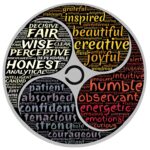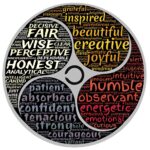In my first post in this exploration of how we can produce meaningful and last life change, I described the four obstacles that prevent change. In my last post on this topic, I introduced you to the five building blocks of change. These steps I just described set the stage for change, but the real work lies ahead. Change can be scary, tiring, frustrating, and repetitious. And change takes time. How much?, you might ask. It depends on your ability to remove the four obstacles to change and embrace the five building blocks I discussed above. It also relies on your ability to commit to the minute-to-minute process of change. But I have found that when someone makes a deep commitment to change, they can expect to see a positive shift in 3-6 months.
With the foundation for positive life change now in place, it’s time to take action. Here are the five steps you must take to turn possibility and hope into real change.
Explore Your Inner World
Perhaps the most difficult part of changing your life involves exploring your inner world. True change cannot just occur on the surface or outside of you. Change means not only understanding who you are, but also why you are who you are, in other words, what makes you tick. The first step you must take is to identify the obstacles that are preventing you from changing. You need to “look in the mirror” and specify what the baggage, habits, emotions, and environment are that are keeping you from your goals. Understanding these obstacles takes the mystery out of who you are and what has been holding you back. It also gives you clarity on what you need to change and gives you an initial direction in your path of change.
These explorations of your inner world can enable you to finally understand why you have been the way you have been and done things you have done even when neither have worked for you (“So that’s why I’ve been this way all of my life!”). This process will also help you to remove the obstacles that have stood in your path to change. These insights also, at a deep level, liberate you to move from your current path to another that will take you where you really want to go. Most importantly, truly understanding your inner world will allow you to finally put the past behind you—when most of your life you have been putting your past in front of you.
Change Goals
Once the path to your goals has been cleared, you still need to have a clear idea about your final destination. Think of its like GPS; you can’t get directions unless you input where you want to go.
When you establish clear objectives of the changes you want to make, you are able to better focus your efforts and direct your energy toward those changes. These goals should identify what areas you want to change, how you will change them, and the ultimate outcome you want to achieve. Moreover, the goals should be specific, objective, and time defined.
Action Steps
So far, everything you have done to change has been talk. Now it’s time to actually make change happen. Action steps describe the particular actions you will take to achieve your change goals. They may range from adhering to an exercise regimen to maintaining emotional control in a crisis situation to staying focused when surrounded by distractions. Action steps give you the specific tools you need to act on the world in the present and to give you alternative actions that counter your old baggage, habits, emotions, and environment.
Forks in the Road
Taking the action steps and achieving your change goals depends on recognizing important forks in the road. I make the distinction between the bad road and the good road (there can actually be multiple bad and good roads, but let’s keep things simple). The bad road is the one that you’ve been on for so long driven by the four obstacles I described above; it’s a “feel bad, do bad” road. In contrast, the good road is the one you want to be on; it’s a “feel good, do good” road.
This fork in the road is simple, but not easy. It’s simple because you would, of course, want to be on the good road. It’s not easy because you have years of baggage, habits, emotions, and environment continuing to propel you down the bad road.
A key to the change process involves recognizing the forks in the road when they appear because without seeing the forks in the road, you obviously can’t take the good road, that is, makes positive changes. This awareness isn’t as easy as it seems because all those years of obstacles has created a myopia that can limit your field of vision causing you to miss the forks when you come upon them.
In all likelihood, you will initially only recognize the forks when you are long past them (“Darn it, I wish I had seen that fork earlier!”). But, with time and vigilance, you will see those forks earlier and earlier until one day an amazing thing will happen; you will see the fork when you arrive at it.
Unfortunately, because of the Sirens’ call of the four obstacles, you will still probably take the bad road at first. But, one day, another amazing thing will happen. You will recognize that fork in the road as you approach it and, yes, you will take it! And you will never be the same person again.
Don’t get me wrong; you don’t have it made yet. You’ll have setbacks and struggles because you will still go down the bad road sometimes; those obstacles take time to dismantle. But every time you take the good road, you’ll see what a great road it is to be on and it will encourage you to continue to resist your baggage, habits, emotions, and environment and to take the good road at the many forks that lay ahead.
Three Ps
One of the most difficult aspects of change is the need to make a day-to-day, hour-to-hour, and minute-to-minute commitment to change (Every time you miss an opportunity for change, you further ingrain your old obstacles). A helpful reminder of this necessity is what I call the Three Ps.
The first P, patience, is a constant reminder that change takes time and that if you maintain your commitment, you have a good chance to make the changes you want long lasting.
The second P, persistence, means you must keep vigilant and, as the saying goes, “keep on keeping on” in your journey to change.
The third P, perseverance, refers to your ability to overcome setbacks and maintain your motivation and confidence in the face of periodic failures and disappointment.
The Payoff
There is an immense payoff for your commitment and efforts at change: A life-altering shift in who you are and how you think, feel, and behave. A new direction that your life will take. And finally moving toward achieving your life goals. As a former client told me so poignantly: “I realized that I would never have to go back to the way I used to live my life, and I have never been so happy!”





